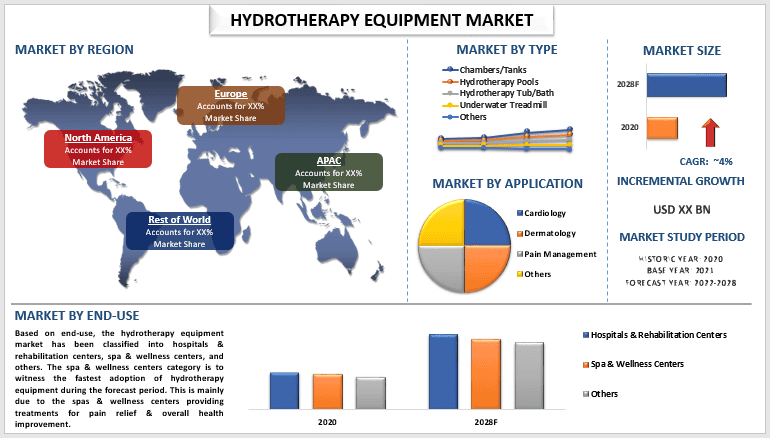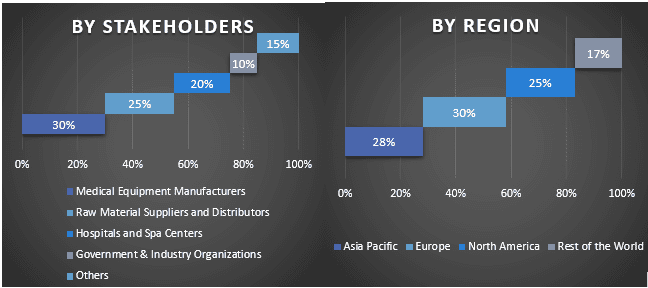- Home
- About Us
- Industry
- Services
- Reading
- Contact Us
Hydrotherapy Equipment Market: Current Analysis and Forecast (2022-2028)
Emphasis on Type (Chambers/Tanks, Hydrotherapy, Pools, Hydrotherapy Tub/Bath, Underwater Treadmill, and Others); Application (Cardiology, Dermatology, Pain Management, and Others); End-Use (Hospitals & Rehabilitation Centers, Spa & Wellness Centers, and Others,); and Region/Country

The global hydrotherapy equipment market is expected to grow at a significant rate of around 4% during the forecast period 2022-2028. The demand for hydrotherapy equipment is growing as hydrotherapy becomes increasingly popular. The market key players extend their worldwide presence and enhance their item contributions to satisfy developing necessities. For the regulation and use of this equipment, some regions have established guidelines. For instance, in 2019, the Healthcare Infection Control Practices Advisory Committee (HICPAC) and the CDC Healthcare Quality Promotion Division oversee the practice of disinfection and cleaning for patients receiving hydrotherapy who have burns, wounds, or other intact skin conditions.
Additionally, hydrotherapy can help alleviate pain, reduce muscle spasms, treat musculoskeletal conditions, and treat head injuries. Hydrotherapy is used to treat a variety of soft tissue and bone injuries, neuromuscular injuries, and other conditions.
EWAC, HydroWorx International Inc., Prime Pacific Health Innovations Corporation, BTL, HYDRO PHYSIO, Technomex, Stas Doyer, Transcom S.L., Kohler Co., Jacuzzi Brands LLC. are some of the key players in the market. Several M&As along with partnerships have been undertaken by these players to facilitate customers with hi-tech and innovative products/technologies.
Insights Presented in the Report
“Amongst type, hydrotherapy pools category to witness robust growth during the forecast period”
Based on type, the market is segmented into chambers/tanks, hydrotherapy pools, hydrotherapy tub/bath, underwater treadmills, and others. Among these, the hydrotherapy pools category is to witness the highest CAGR during the forecast period owing to the factors that can be attributed to the rising utilization of hydrotherapy in various applications and technological advancements. For instance, HydroWorx launched the rejuvenate line of plunges, majorly for use in athletic recovery programs in November 2019.
“Amongst application, the pain management to hold a significant share in the market in 2020”
On the basis of application, the market is categorized into cardiology, dermatology, pain management, and others. Among these, pain management to hold a significant share of the market in 2020. This is primarily attributable to the rising number of spinal cord injuries and the increasing use of the equipment by athletes’ associations, surgeons, and other medical professionals, both of which contribute to the market’s expansion. For instance, according to the National Spinal Cord Injury Statistical Center (NSCISC), the most recent estimate of the annual incidence of traumatic spinal cord injury (SCI) is approximately 54 cases per one million people in the United States, which equals about 18,000 new SCI cases each year.
“North America to hold a significant share in the market”
For a better understanding of the market adoption of the hydrotherapy equipment industry, the market is analyzed based on its worldwide presence in the countries such as North America (U.S., Canada, and the Rest of North America), Europe (Germany, U.K., France, Spain, Italy, Rest of Europe), Asia-Pacific (China, Japan, India, Rest of Asia-Pacific), Rest of World. North America is anticipated to hold a significant share of the market. This is mainly due to the rising awareness regarding the health benefits of aquatic therapy for injured and disabled people, well-established healthcare infrastructure, high income, and the rising incidence of arthritis in the region driving the growth of the hydrotherapy equipment market. For instance, the Centers for Disease Control and Prevention (CDC), 26 percent (one in 4) of adults in the United States have some type of disability.
Reasons to buy this report:
- The study includes market sizing and forecasting analysis validated by authenticated key industry experts.
- The report presents a quick review of overall industry performance at one glance.
- The report covers an in-depth analysis of prominent industry peers with a primary focus on key business financials, product portfolio, expansion strategies, and recent developments.
- Detailed examination of drivers, restraints, key trends, and opportunities prevailing in the industry.
- The study comprehensively covers the market across different segments.
- Deep dive regional level analysis of the industry.
Customization Options:
The global hydrotherapy equipment market can further be customized as per the requirement or any other market segment. Besides this, UMI understands that you may have your own business needs, hence feel free to connect with us to get a report that completely suits your requirements.
Table of Content
Research Methodology for the Hydrotherapy Equipment Market Analysis (2022-2028)
Analyzing the historical market, estimating the current market, and forecasting the future market of the global hydrotherapy equipment market were the three major steps undertaken to create and analyze the adoption of the hydrotherapy equipment market in major regions globally. Exhaustive secondary research was conducted to collect the historical market numbers and estimate the current market size. Secondly, to validate these insights, numerous findings and assumptions were taken into consideration. Moreover, exhaustive primary interviews were also conducted, with industry experts across the value chain of the global hydrotherapy equipment market. Post assumption and validation of market numbers through primary interviews, we employed a top-down/bottom-up approach to forecasting the complete market size. Thereafter, market breakdown and data triangulation methods were adopted to estimate and analyze the market size of segments and sub-segments of the industry pertains to. Detailed methodology is explained below:
Analysis of Historical Market Size
Step 1: In-Depth Study of Secondary Sources:
Detail secondary study was conducted to obtain the historical market size of the hydrotherapy equipment market through company internal sources such as annual reports & financial statements, performance presentations, press releases, etc., and external sources including journals, news & articles, government publications, competitor publications, sector reports, third-party database, and other credible publications.
Step 2: Market Segmentation:
After obtaining the historical market size of the hydrotherapy equipment market, we conducted a detailed secondary analysis to gather historical market insights and share for different segments & sub-segments for major regions. Major segments are included in the report as type, application, and end-use. Further country-level analyses were conducted to evaluate the overall adoption of testing models in that region.
Step 3: Factor Analysis:
After acquiring the historical market size of different segments and sub-segments, we conducted a detailed factor analysis to estimate the current market size of the hydrotherapy equipment market. Further, we conducted factor analysis using dependent and independent variables such as various type, application, and end-use of the hydrotherapy equipment market. A thorough analysis was conducted for demand and supply-side scenarios considering top partnerships, mergers and acquisitions, business expansion, and product launches in the hydrotherapy equipment market sector across the globe.
Current Market Size Estimate & Forecast
Current Market Sizing: Based on actionable insights from the above 3 steps, we arrived at the current market size, key players in the global hydrotherapy equipment market, and market shares of the segments. All the required percentage shares split, and market breakdowns were determined using the above-mentioned secondary approach and were verified through primary interviews.
Estimation & Forecasting: For market estimation and forecast, weights were assigned to different factors including drivers & trends, restraints, and opportunities available for the stakeholders. After analyzing these factors, relevant forecasting techniques i.e., the top-down/bottom-up approach were applied to arrive at the market forecast for 2028 for different segments and sub-segments across the major markets globally. The research methodology adopted to estimate the market size encompasses:
- The industry’s market size, in terms of revenue (USD) and the adoption rate of the hydrotherapy equipment market across the major markets domestically
- All percentage shares, splits, and breakdowns of market segments and sub-segments
- Key players in the global hydrotherapy equipment market in terms of products offered. Also, the growth strategies adopted by these players to compete in the fast-growing market
Market Size and Share Validation
Primary Research: In-depth interviews were conducted with the Key Opinion Leaders (KOLs) including Top Level Executives (CXO/VPs, Sales Head, Marketing Head, Operational Head, Regional Head, Country Head, etc.) across major regions. Primary research findings were then summarized, and statistical analysis was performed to prove the stated hypothesis. Primary research input was consolidated with secondary findings, turning information into actionable insights.
Split of Primary Participants in Different Regions

Market Engineering
The data triangulation technique was employed to complete the overall market estimation and to arrive at precise statistical numbers for each segment and sub-segment of the global hydrotherapy equipment market. Data was split into several segments & sub-segments post studying various parameters and trends in the areas of type, application, and end-use in the global hydrotherapy equipment market.
The Main Objective of the Global Hydrotherapy Equipment Market Study
The current & future market trends of the global hydrotherapy equipment market were pinpointed in the study. Investors can gain strategic insights to base their discretion for investments on the qualitative and quantitative analysis performed in the study. Current and future market trends determined the overall attractiveness of the market at a regional level, providing a platform for the industrial participant to exploit the untapped market to benefit from a first-mover advantage. Other quantitative goals of the studies include:
- Analyze the current and forecast market size of the hydrotherapy equipment market in terms of value (USD). Also, analyze the current and forecast market size of different segments and sub-segments
- Segments in the study include areas of type, application, and end-use.
- Define and analysis of the regulatory framework for the hydrotherapy equipment market industry.
- Analyze the value chain involved with the presence of various intermediaries, along with analyzing customer and competitor behaviors of the industry.
- Analyze the current and forecast market size of the hydrotherapy equipment market for the major region.
- Major countries of regions studied in the report include Asia Pacific, Europe, North America, and the Rest of the World.
- Company profiles of the Hydrotherapy Equipment Market and the growth strategies adopted by the market players to sustain in the fast-growing market
- Deep dive regional level analysis of the industry
Related Reports
Customers who bought this item also bought










